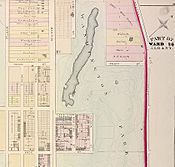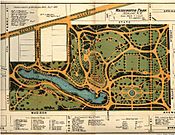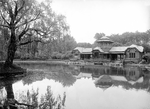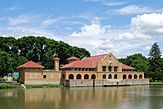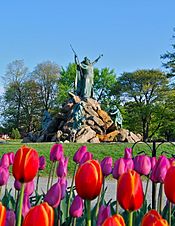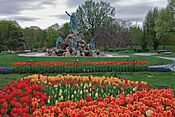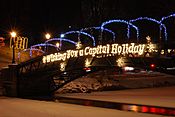Washington Park Historic District (Albany, New York) facts for kids
Quick facts for kids |
|
|
Washington Park Historic District
|
|

A photographer at Tulip Fest
|
|
| Location | Washington Park and surrounding properties, Albany, New York |
|---|---|
| Area | 136 acres (0.55 km2) |
| Architect | John Bogart and John Cuyler (for park) multiple for residences including HH Richardson and Stanford White |
| NRHP reference No. | 72000818 |
| Added to NRHP | June 19, 1972 |
Washington Park in Albany, New York is a super important park in the city. Lots of festivals and fun events happen here! This land has been public property since 1686. It has been used for many things, like storing gunpowder, as a parade ground, and even as a cemetery.
Many people think the famous park designer Frederick Law Olmsted created Washington Park. While he didn't design it, the park uses many of his ideas. These are the same ideas he used for Central Park in Manhattan. The park is about 81 acres (33 ha) big. It has a 5.2-acre (2.1 ha) Washington Park Lake in its southwest corner. This lake is about 1,600-foot-long (490 m) and 140-foot-wide (43 m).
The park is historic, and so is the neighborhood around it. Many amazing buildings line the streets facing the park. Famous architects from the late 1800s, like Henry Hobson Richardson, designed some of them. At least two governors of New York lived in these buildings when they weren't in office. Because of its history and cool buildings, the park and neighborhood became the Washington Park Historic District in 1972. In 1998, the American Association of Architects called it one of the nation's 100 most important parks. A composer named Peter Child even wrote music inspired by the park in 2008!
Contents
Discovering Washington Park's Past
From Cemetery to Public Square
Washington Park has been public land since Albany became a city in 1686. The city's original charter said that all land not privately owned belonged to the city. This included the area that would become Washington Park.
In 1802, a part of the land was used to store gunpowder. By 1806, some areas became the Middle Public Square. In 1800, land to the west was set aside for a cemetery. It had sections for different churches, African-Americans, and even strangers. In 1809, the Middle Public Square was renamed Washington Square. Later, it became the Washington Parade Ground. In 1868, all the graves and headstones from the cemetery were moved. Most went to Albany Rural Cemetery.
For many years, important citizens and newspapers in Albany wanted a big public park. In 1869, Frederick Law Olmsted's company was hired to plan one. They imagined Washington Park as the main part of a series of parks and roads. This was similar to what they designed in Buffalo, Boston, and Brooklyn. Even though Olmsted's company didn't design the park itself, their big ideas were used. This included the idea of blocking the Beaver Kill (Beaver Creek) to create a large lake.
Building the Park: A Grand Vision
In 1869, the New York Legislature passed a law to create a large public park. They also created a group called the Board of Trustees of the Washington Park of the City of Albany. John Bogart and John Cuyler drew the plans for Washington Park in 1870. Bogart had worked on Central Park in New York.
Work on the Washington Parade Grounds started in July 1870 and finished by the end of that year. In 1871, the old cemetery area was turned into part of the park. In 1873, they focused on the western part of the park. This included building a dam on the Beaverkill to form Washington Park Lake. A footbridge was built over the lake in 1875.
In 1880, nine acres of row houses were bought, torn down, and turned into park land. This area later became the King Memorial Fountain. The last part of the park to be bought was John Taylor's large house and land in 1882. This area has been used for tennis courts since 1889. The northwest corner of the park was never bought. It became urban mansions.
The total cost to build the park, including buying land and improving roads, was over $1 million. The park's commissioners also gained power to build and care for roads leading to the park. They built Western Avenue and Northern Boulevard (now Manning Boulevard). They also took control of other parks in the city. In 1900, the park board became part of the city's Department of Public Works.
Washington Park Today
In 1958, Lancaster Street was extended through the park. Northern Boulevard was also made wider. In 1988, Washington Park Road was renamed Albany Plan of Union Avenue. This was to honor a meeting held in Albany by Benjamin Franklin. In 1991, Northern Boulevard was renamed Henry Johnson Boulevard. This honored World War I hero Henry Johnson.
In the 1950s, a disease killed all the elm trees in the park. Crab apple trees were planted to replace them. In the 1990s and 2000s, Washington Park got a big makeover. Flower beds were fixed, and new disease-resistant elm trees were planted. The King Fountain was lit up at night, and the lilac bushes around the park were restored.
Cool Structures in the Park
Washington Park used to have many buildings. These included shelters, a pavilion, and a lakehouse. The original wooden lake house was replaced in 1929 with a "modern" brick building. The other old buildings are gone now. The footbridge over Washington Park Lake, built in 1875, is the only original structure left. Its lamps were gas lamps at first, but they got electricity in 1881.
The current Washington Park Lake House was built in 1929. It replaced the original stick style building from 1876. It looks like Spanish Revival style. It's made of terracotta, terrazzo, brick, and guastavino tile. The area in front of the lake house is used for plays by the Park Playhouse. There's a 900-seat outdoor theater there. Over 60,000 people visit every year!
Monuments and Statues
- Dr. James H. Armsby Memorial is a statue of James H. Armsby. He helped start Albany Medical College. This statue was put up in 1879.
- Robert Burns Statue is a bronze statue of the famous Scottish poet Robert Burns. It was put up in 1888. Four panels around its base show his poems.
- King Memorial Fountain is a fountain with a large bronze statue of Moses. It shows him hitting a rock to get water on Mount Horeb. Four figures around the statue represent different stages of life. This fountain was a gift from Rufus H. King in 1893. It was sculpted by J. Massey Rhind.
- Marinus Willett Memorial is a monument to Colonel Marinus Willett. It remembers his bravery during the French and Indian Wars. It's a huge 33,000-pound (15,000 kg) boulder with a plaque. It was moved in 2006 to a safer spot.
- Soldiers and Sailors' Monument is a marble monument with a bronze statue. It represents "The Nation at Peace Won Through Victorious War." It honors Civil War veterans. It was finished in 1911 and put up in 1912. It was restored in 1986 and renamed the Albany Veterans Memorial Monument.
- Henry Johnson Memorial is a statue of World War I hero Henry Johnson. It's located at an intersection near the park. It was put up in 1991.
Fun Activities at Washington Park
Washington Park offers many activities for everyone! You can play boccie, volleyball, and badminton in the open spaces. The city also has tennis, basketball, and handball courts. You can go ice skating on Washington Park Lake in winter, but swimming is not allowed. Bicycling is popular on the park's many roads. Some roads are even closed to cars. Skateboarding is allowed in most of the park. However, it's not allowed on monuments or sports courts.
The park hosts many festivals, concerts, and special events. The Tulip Festival happens every year since 1949. It features 200,000 blooming tulips! The African-American tradition of Pinksterfest is also part of the Tulip Fest. The Latin Festival and the Columbus Day Parade are other yearly events. Every winter, the Capital Holiday Lights display lights up the park with 125 displays. The money raised helps prevent youth crime.
Many charity events also take place here. These include the American Cancer Society walkathon and the Freihofer's Run for Women. The Freihofer's Run is a big race that attracts professional runners from all over the world. It's one of the largest all-women races globally!
Exploring the Historic Neighborhood
The streets around Washington Park are part of the Washington Park Historic District. This includes State Street, Willett Avenue, Madison Avenue, and South Lake Avenue. Most of the buildings here were built after the 1880s.
State Street: Grand Homes and History
State Street is on the north side of Washington Park. Over 60 townhouses face the park here. Most are made of brick or brownstone and are three stories tall. Many were built for important people like bankers and politicians. Famous architects like Henry Hobson Richardson and Stanford White designed some of them. These homes have beautiful details like decorative tiles and stone. The First Presbyterian Church, built in 1882, is on the corner of State and Willett. It has four special Tiffany windows. New York Governor John Alden Dix lived at 491 State Street.
Willett Street: A Mix of Styles
Willett Street runs along the east side of the park. It's mostly residential, with about 33 buildings. You can see many different building styles here. These include Queen Anne, Spanish Revival, Classical revival, and Italianate. Two larger apartment buildings break up the row of older townhouses. One of them, The Willett, was built in 1909. It sits where the New York State Normal College used to be. The oldest building on Willett with its original look was built in 1872. Martin Glynn, a former New York governor, lived at 28 Willett Street. He was the first Catholic New York governor.
Madison Avenue: Busy and Diverse
Madison Avenue is a busy street on the south side of the park. About 90 buildings on Madison Avenue face the park. East of Robin Street, you'll see 19th-century rowhouses. West of Robin Street, there are larger detached residences. Many of these have been turned into medical offices. Some buildings, like 694 and 710 Madison, are older than the park improvements across the street.
South Lake Avenue: Elegant Rowhouses
South Lake Avenue, facing Washington Park, has 23 rowhouses. It also has a modern apartment building and a converted carriage house. The Elouise Apartments, built in 1927, are eight stories tall. Many of the homes here have yellow brick fronts.
Englewood Place and Thurlow Terrace: Park-like Streets
Englewood Place and Thurlow Terrace were built and cared for by the park commissioners. They wanted these streets to look like part of the park. Large mansions were built on Englewood Place between 1879 and 1887. Some were designed by Robert Gibson. 5 Englewood Place became the home of the University at Albany's president. Thurlow Terrace was developed later. 8 Thurlow Terrace was where the Albany Catholic bishops lived until 1957.
|






